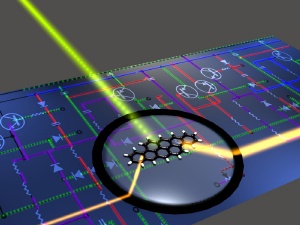Jul 2 2009
ETH Zurich researchers have successfully created an optical transistor from a single molecule. This has brought them one step closer to an optical computer.
 An artist vies of a photonic circuit with molecular building blocks. A single-molecule optical transistor is depitcted using a standard symbol for an electronic transistor. (Image: Robert Lettow)
An artist vies of a photonic circuit with molecular building blocks. A single-molecule optical transistor is depitcted using a standard symbol for an electronic transistor. (Image: Robert Lettow)
Internet connections and computers need to be ever faster and more powerful nowadays. However, conventional central processing units (CPUs) limit the performance of computers, for example because they produce an enormous amount of heat. The millions of transistors that switch and amplify the electronic signals in the CPUs are responsible for this. One square centimeter of CPU can emit up to 125 watts of heat, which is more than ten times as much as a square centimeter of an electric hotplate.
Photons instead of electrons
This is why scientists have been trying for some time to find ways to produce integrated circuits that operate on the basis of photons instead of electrons. The reason is that photons do not only generate much less heat than electrons, but they also enable considerably higher data transfer rates.
Although a large part of telecommunications engineering nowadays is based on optical signal transmission, the necessary encoding of the information is generated using electronically controlled switches. A compact optical transistor is still a long way off. Vahid Sandoghdar, Professor at the Laboratory of Physical Chemistry of ETH Zurich, explains that, “Comparing the current state of this technology with that of electronics, we are somewhat closer to the vacuum tube amplifiers that were around in the fifties than we are to today’s integrated circuits.”
However, his research group has now achieved a decisive breakthrough by successfully creating an optical transistor with a single molecule. For this, they have made use of the fact that a molecule’s energy is quantized: when laser light strikes a molecule that is in its ground state, the light is absorbed. As a result, the laser beam is quenched. Conversely, it is possible to release the absorbed energy again in a targeted way with a second light beam. This occurs because the beam changes the molecule’s quantum state, with the result that the light beam is amplified. This so-called stimulated emission, which Albert Einstein described over 90 years ago, also forms the basis for the principle of the laser.
Focusing on a nano scale
Jaesuk Hwang, first author of the study and a scientific member of Sandoghdar’s nano-optics group, explains that, “Amplification in a conventional laser is achieved by an enormous number of molecules.” By focusing a laser beam on only a single tiny molecule, the ETH Zurich scientists have now been able to generate stimulated emission using just one molecule. They were helped in this by the fact that, at low temperatures, molecules seem to increase their apparent surface area for interaction with light . The researchers therefore needed to cool the molecule down to minus 272 degrees Celsius (minus 457.6 degrees Fahrenheit), i.e. one degree above absolute zero. In this case, the enlarged surface area corresponded approximately to the diameter of the focused laser beam.
Switching light with light
By using one laser beam to prepare the quantum state of a single molecule in a controlled fashion, scientists could significantly attenuated or amplify a second laser beam. This mode of operation is identical to that of a conventional transistor, in which electrical potential can be used to modulate a second signal.
Innovative computer still a long way off
Thus component parts such as the new single molecule transistor may also pave the way for a quantum computer. Sandoghdar says, “Many more years of research will still be needed before photons replace electrons in transistors. In the meantime, scientists will learn to manipulate and control quantum systems in a targeted way, moving them closer to the dream of a quantum computer.”